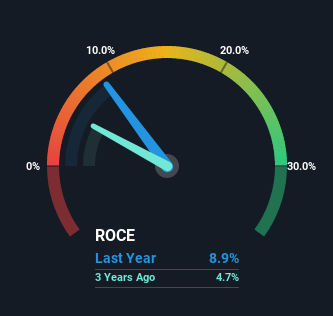
What are the early trends we should look for to identify a stock that could multiply in value over the long term? Ideally, a business will show two trends; firstly a growing return on capital employed (ROCE) and secondly, an increasing amount of capital employed. Put simply, these types of businesses are compounding machines, meaning they are continually reinvesting their earnings at ever-higher rates of return. Speaking of which, we noticed some great changes in TradeDoubler's (STO:TRAD) returns on capital, so let's have a look.
Return On Capital Employed (ROCE): What Is It?
Just to clarify if you're unsure, ROCE is a metric for evaluating how much pre-tax income (in percentage terms) a company earns on the capital invested in its business. The formula for this calculation on TradeDoubler is:
Return on Capital Employed = Earnings Before Interest and Tax (EBIT) ÷ (Total Assets - Current Liabilities)
0.089 = kr35m ÷ (kr898m - kr502m) (Based on the trailing twelve months to June 2022).
So, TradeDoubler has an ROCE of 8.9%. On its own that's a low return on capital but it's in line with the industry's average returns of 8.9%.
Check out the opportunities and risks within the SE Media industry.

Historical performance is a great place to start when researching a stock so above you can see the gauge for TradeDoubler's ROCE against it's prior returns. If you want to delve into the historical earnings, revenue and cash flow of TradeDoubler, check out these free graphs here.
What The Trend Of ROCE Can Tell Us
Shareholders will be relieved that TradeDoubler has broken into profitability. The company now earns 8.9% on its capital, because five years ago it was incurring losses. While returns have increased, the amount of capital employed by TradeDoubler has remained flat over the period. That being said, while an increase in efficiency is no doubt appealing, it'd be helpful to know if the company does have any investment plans going forward. Because in the end, a business can only get so efficient.
On a separate but related note, it's important to know that TradeDoubler has a current liabilities to total assets ratio of 56%, which we'd consider pretty high. This effectively means that suppliers (or short-term creditors) are funding a large portion of the business, so just be aware that this can introduce some elements of risk. While it's not necessarily a bad thing, it can be beneficial if this ratio is lower.
What We Can Learn From TradeDoubler's ROCE
To bring it all together, TradeDoubler has done well to increase the returns it's generating from its capital employed. Considering the stock has delivered 26% to its stockholders over the last five years, it may be fair to think that investors aren't fully aware of the promising trends yet. Given that, we'd look further into this stock in case it has more traits that could make it multiply in the long term.
TradeDoubler does have some risks though, and we've spotted 1 warning sign for TradeDoubler that you might be interested in.
While TradeDoubler may not currently earn the highest returns, we've compiled a list of companies that currently earn more than 25% return on equity. Check out this free list here.
Valuation is complex, but we're here to simplify it.
Discover if TradeDoubler might be undervalued or overvalued with our detailed analysis, featuring fair value estimates, potential risks, dividends, insider trades, and its financial condition.
Access Free AnalysisHave feedback on this article? Concerned about the content? Get in touch with us directly. Alternatively, email editorial-team (at) simplywallst.com.
This article by Simply Wall St is general in nature. We provide commentary based on historical data and analyst forecasts only using an unbiased methodology and our articles are not intended to be financial advice. It does not constitute a recommendation to buy or sell any stock, and does not take account of your objectives, or your financial situation. We aim to bring you long-term focused analysis driven by fundamental data. Note that our analysis may not factor in the latest price-sensitive company announcements or qualitative material. Simply Wall St has no position in any stocks mentioned.
About OM:TRAD
TradeDoubler
Provides performance marketing and technology solutions for publishers and advertisers worldwide.
Excellent balance sheet with reasonable growth potential.
Market Insights
Community Narratives



